Attic AMSAT Antenna – Working the Ham Radio Satellites
With A Rotatable, Computer Controlled, Yagi Attic Antenna
(I am finally getting around to writing this webpage on my attic satellite antenna system. While I no longer have this setup, I have received a lot of requests for details on this system from other hams wanting to work the satellites but who suffer from similar HOA constraints.)
Bottom line: it’s absolutely worth the effort!
Note that this same approach for working the ham radio satellite would work great on balconies too!
Out Standing In Our Fields
A lot of us AMSAT geeks really enjoy working the dozen or more ham radio satellites while we are out standing in our fields…and roads and hills and beaches and mountaintops and…Well, yougettheidea.
I personally find it very cool to be able to use an HT and a handheld beam antenna and bounce my signal off a satellite 600 to 700 miles out in space that is traveling over 16,000 miles an hour – helping me have a conversation with another ham on the other side of the United States or Canada – or with someone in the Caribbean or all the way down to Brazil in South America.
(I am located on the East Coast 13 miles from the White House.)
However, as much fun as those fields and roads and hills etc. can be, for a lot of us less stalwart hams, we would like to do at least some of our satellite operating in the comfort of our own ham shack – without chasing 10 to 15 minute windows of satellite visibility that can just as often be during rainy days or in the middle of the night. Or, in the middle of rainy nights!
To quote the ham SN0OPY after one of his HT satellite sojourns, “It was a dark and stormy night.”
Once the decision for comfort has been reached, other constraints that don’t seem so comfortable raise their ugly heads: allocatable funds for ham radio, cooperative family members, and, too often, extremely uncooperative HOA organizations.
The purpose of this webpage is to offer a solution that I used with some success to solve the above issues and constraints.
The Good Old Days – And Then There Was Cliff Dwelling
Once upon a time 20 years ago, when we had the big house, I had a great AMSAT antenna system set up on the roof and was able to work every operational voice and digital ham radio satellite that was circling the earth.
My set up included two switchable cross polarized yagi antennas: 22 elements on 2 meters and a 16 element on 435 MHz with a Yaesu G–5400 az-el rotor, mast mounted preamps, etc.
Ahh, the good old days.
However, after selling the big house, I lived in high-rise condos and became a cliff dweller for the next two decades.
The consequence of this living decision meant that I was very limited when it came to ham radio antennas for all bands and all modes.
While living 100 yards from the Gulf of Mexico shore, I did come up with a hokey system to work the satellites using an arrow antenna, tripod and a cheap camera tilt and pan contraption that worked pretty well if the satellite was on my balcony’s side of the building.
(The salt air was not good for the Arrow – and neither was the unexpected 50 MPH gale force wind that did it in.)
For details on that experiment, please click this link:
The K3RRR El Cheapo AZ-EL Rotor System for AMSAT Birds
Note that I believe this system described on this webpage, particularly with the optional computer control described below, is much better for balconies than my El Cheapo approach.
Back to a Single Family Home – However…
For the first time in two decades, we are now living in a single-family home again so my antenna options have improved. That’s the good news.
The bad news is that, like 23% of Americans, we live in an HOA restricted home. This means that I have a lot of attic antennas.
(While I had this attic antenna, I had and continue to have two stealth 9:1 unun fed longwires (175′ and 123′) that are outside – but more about those on another page.)
Wanting to get back on the amateur satellites, I decided to pursue at least a minimal set up in the attic. So, I had to figure out what additional stuff I could stuff in my attic!
At the time of these attic adventures, my attic antennas included: 2 m and 440 J-Pole; 2 m and 440 slim jim; 9:1 unun fed 32 foot longwire, a Diamond Discone antenna and a noise dipole cut for 20 m to use with my MFJ 1026 noise canceling filter.
I originally tried to use my J-Pole for satellite work hoping that the 435 MHz preamp would compensate for the attic location and a less than ideal antenna. Unfortunately, there was little if any joy when the preamp was switched off – and an S9 no joy noise level with it switched on.
Given this result, I decided that I might, just maybe, have room for one more antenna – to work effectively operate satellites again in comfort.
Back to the Attic With One More Antenna
The photos show my kludged up HOA-restrictions-required attic antenna that I assembled over a couple of months: an Elk log periodic which I already owned, a cheap azimuth-only TV rotor, a 440 MHz preamp, a 2″ x 6″ board –  and a lot of PVC.
and a lot of PVC.
All of this was designed so that it would lift directly up through the small attic access hole while also barely fitting the ceiling space available in our attic.
The mounting board was pre-drilled for 3/16 inch nails which were used to tack it down to the floor joists so that only the antenna turned.
The whole K3RRR contraption construction list that I used for my attic satellite antenna system included the following:
- Elk 2M/440L5 Dual-Band Antenna
- 2 feet of 1 inch schedule 40 PVC
- 2 feet of 1 1/4 inch schedule 40 PVC
- 1″ to 1 1/4 inch PVC connector
- Channel Master CM9521A TV rotor
- Winegard DS-2000 Universal Antenna Mount
- MFJ KP2-440 preamp (which I would not recommend to my worst enemy. Okay, maybe to him but to nobody else.)
- 26″ 2″ x 6″ board
Note that the PVC mast length for your location may vary considerably depending upon your roof, joist, rafter design and spacing. In other words, measure 16 times and cut once.
We have standard 24″ joists so I just cut a board that was a bit longer and marked the board for the drilled holes.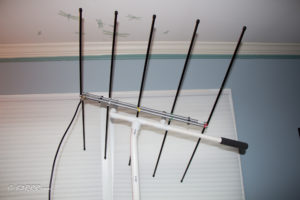
This is a photo of the Elk 2M/440L5 Dual-Band Antenna (cost is about $125 new….I bought this one on eBay for about $80.)
I used it originally for handheld contacts with my HT for SO-50 and AO-85 satellite contacts.
Note the foam handle is included as part of the Elk as delusional propaganda to convince you that a law of physics is not true: “The longer you hold something – the heavier it gets!” Seriously, the foam does help when you get sweaty palms working portable.
The good news is that nothing is glued on this set up so it is easy to pop off the entire antenna and still use it portable.
Note that this antenna requires that the feedline leave the connection at 90 degrees for a few feet for it to be properly resonant on both 2 meters and 435 MHz.
After the first photos were taken, I moved the preamp to the rotator mount and replaced the LMR240 jumper cable between the antenna and preamp with LMR400 Ultraflex. LMR 400 connected this to the shack equipment I had back then: a Yaesu FT897D for the downlink and a Yaesu FT 857D for the uplink with a Diamond duplexer to split the feed line 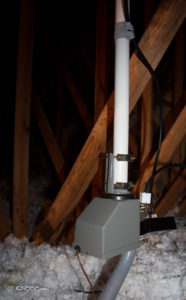 between both radios.
between both radios.
These Are My Results With An Attic
Antenna- But Your Mileage May Vary
Having used this for a while, I discovered that with this antenna, as expected, good reception was only received at elevations of 5° to 45°.
(Yes, I know that this rotor is only for azimuth and not for elevation also. As it turns out, if you attach your antenna with a fixed elevation of about 15°, you can work 70% or more of the satellite passes that come your way. See the fantastic, detailed PS below written by Bob, WB4APR that explains the reasoning behind this statement.)
Note the photo below. If you have played with PVC for antennas for a while you will already know they don’t make 15° connectors. So, I was faced with trying to bend a straight piece PVC – which I thought was going to be difficult.
As it turns out, it is surprisingly trivial to heat even Schedule 40 PVC so that it becomes bendable with a standard 1500 W hair dryer in less than 10 minutes of your time! (Thanks to YouTube for this education!)
This system was working great with FO-29 which was giving me S5 to S7 above the noise. However, I had a much more difficult time receiving SO-50 and to a lesser extent with AO-85.
When I used the Elk handheld and worked these two FM birds with an HT, there was a lot of twisting and turning of the antenna to maximize signal with the usual conclusion that there were no conclusions as to what worked best.
Obviously, with the antenna in the attic, there’s a lot less opportunity for twisting and turning.
As a consequence, there’s not a lot that can be done to improve the SO-50 oor AO 85 signals to make them be as good as FO-29. Don’t get me wrong. There are passes of both of these FM satellites that you can work with this set up but don’t be surprised if there are just as many passes that you cannot work.
One thing I did not do was split the antenna feed from the single antenna so that I had two LMR400 runs. By doing this, you could have mast mounted pre-amps for both 440 and 144 which might have help reception on AO-85. Just bear in mind that if you do have pre-amps in the attic, you do not want max gain or the noise will be overwhelming. Adjust the gain control on the pre-amps so you have 2-3 S units without signal if you can. If the noise in the attic is already above that, you can maybe still hear some improved S/N but…
However, my favorite satellite has been and still is FO 29 and I highly recommend attic addicts try that bird for those of you who have all mode capability.
Note: It’s been over two years since I had this attic antenna. In that interim, there are several additional birds available now that were not circling the earth back then. My intuition is that this attic antenna would work great with the three Chinese birds and probably others – so your universe of attic opportunities has been greatly expanded!
As I had mentioned, I had massive noise with the preamp when using the J-Pole.
I had much better success with the Elk…but still had S5 noise when pointed 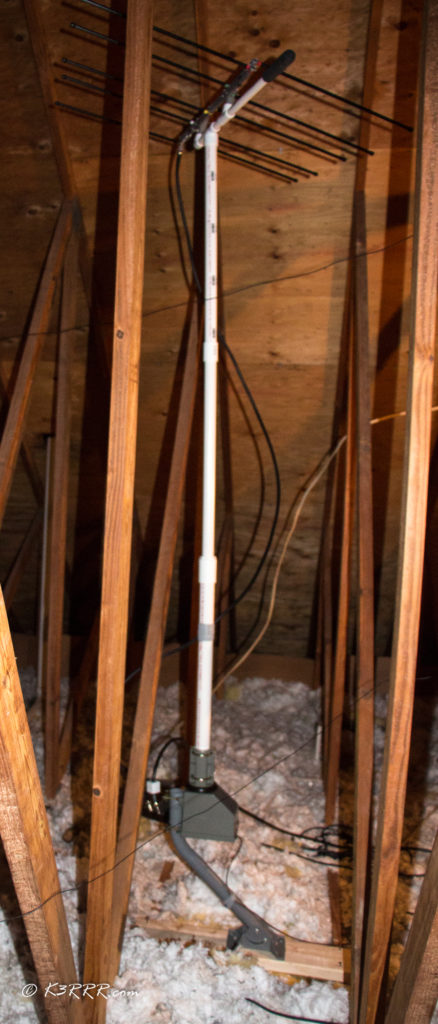 between 88 degrees to 112 degrees.
between 88 degrees to 112 degrees.
I never did figure out what the noise source was…but it was definitely less noise when the antenna was horizontal.
I personally live in RF Hell – otherwise known as Potomac Maryland – so a lot of these problems may be very specific to my QTH.
Just know that when it comes to amateur satellite reception, it does not take much noise to wipe out the signal.
The Final Contraption
Here is a photo of the K3RRR Satellite Attic Contraption after installation.
Note that the preamp has been moved to the rotator mount so it doesn’t move, the jumper cable is now LMR400 Flex and that I had to add another 2′ of PVC to the mast to clear the rafters and the 9:1 balun endfed and noise antenna for the MFJ-1026.
As for me, health reasons, along with my wife’s adamant prohibitions, constrain me from either climbing on roofs or in attics anymore.
However, Wonderful Wife Jan makes up for it by doing all the attic antenna work for me!
So a shout out of gratitude and thanks to Jan for her uncountable number of trips up and down the ladder in the heat of summer to a sweltering attic to tweak this and adjust that – until all was right in Heaven and on Earth.
There are certain benefits of having a wife who is 14 years younger! You heard it here first.
What I Would Do Different If I Were Back in the Attic
When I was using this system in the attic, I was manually controlling the cheap $120 Channel Master 9521A Antenna TV Rotor. I was doing this out of ignorance and have since learned of a very inexpensive way to computer control this cheap TV rotor!
Note: This whole approach will work with just about any infrared controlled rotator. It does not have to be the Channel Master 9521A Antenna TV Rotor.
Cheap Computer Control of My Cheap TV Antenna Rotor – PstRotator and the USB-UIRT
Friend Robin recommended that I check out a program called PstRotator. I chatted with the developer, Codrut YO3DMU, in Romania and he said all I needed was his software and the magic hardware that made all this work: the Jon Rhees USB-UIRT USB Universal Infrared Receiver and Transmitter that cost me about $65 delivered.
One nice thing about the USB – UIRT is that it allows for an external IR emitter. As it turns out, I happen to have one of these left over from an old Windows Media Center remote that worked fine for this application after I attached it with a little rubber cement to the Channel Master 9521A Antenna TV Rotor control.
The great thing is that the USB – UIRT is totally plug-and-play once you download the drivers from the USB – UIRT website. There is no programming or software involved with the gizmo.
Add to this the €20 (about $21) for Codrut’s PstRotator software and the combination of this hardware and this software was as close to plug-and-play as I’ve seen in a while.
On top of this, as it turns out, PstRotator also includes its own Satellite Tracking Module (actually, the best set tracking software I have found) for no extra charge!
So, for less than $90, you can computer control your Attic Elk Antenna.
Full details are available at my webpage that describes the satellite antenna system that evolved from this attic approach:
Suggestions for Improvement?
Since I have the construction skills sets of an eight year old, many of you will probably have suggestions that will greatly improve upon my design.
Please leave those thoughts, ideas and suggestions in the comments below that will help make this approach better for others who may attempt a Rotatable Yagi Attic Antenna for working the AMSAT satellites.
See you on the birds!
73 / 72,

K3RRR
-.- …– .-. .-. .-.
73 de Robert K3RRR
http://K3RRR.com
@K3TripleR
http://YouTube.com/user/K3RRR
-.- …– .-. .-. .-.
PS: It also occurs to me that this setup might be useful for portable use too since nothing is glued. This might be especially good for both satellite and 2 Meter /440 contacts on Field Day and for other contests. It also will work great for those folks who just enjoy working terrestrial FM repeaters if they turn the Elk so the elements are vertical!
PPS: With regard to “only” have an azimuth rotator, here is a great analysis by Bob, Wb4APR
[amsat-bb] Re: Satellite Average Elevation & New Birds
Robert Bruninga bruninga at usna.edu
Wed Dec 18 06:16:56 PST 2013
The geometry of LEO satellites has not changed. The optimum angle for a fixed tilt modest gain YAGI is about 15 degrees (assuming you have a decent horizon).
See: http://aprs.org/LEO-tracking.html
That said, if your antenna is seriously blocked from all directions below say 10 degrees, then you are not going to hear anything down there anyway. So bump it up to say 20 or 25. But 70% of all LEO passes are below 22 degrees so just recognize that you are giving up most of your operations.
Bob, Wb4aPR
—–Original Message—–
From: amsat-bb-bounces at amsat.org [mailto:amsat-bb-bounces at amsat.org] On
Behalf Of Clayton Coleman
Sent: Tuesday, December 17, 2013 8:35 PM
To: Ted
Cc: AMSAT-BB
Subject: [amsat-bb] Re: satellite average elevation & new birds
Just a short time ago after I moved into a new shack, I operated for a month with an Elk at 15 degrees on a tripod. Armstrong rotor. I worked all the current satellites right up through the first week we had AO-73’s transponder available.
Pay close attention to comments WB4APR has made about setting the fixed elevation based on the lowest horizon you can work. For example, if it takes ten degrees for you to clear a mountain, twenty five degrees is probably okay. If you have a clear horizon view, fifteen is probably okay. The goal is to have as much gain available at your lowest elevation to increase your available range. YMMV
PS A preamp goes a long way in a fixed elevation setup.
73
Clayton
W5PFG
On Dec 17, 2013 7:24 PM, “Ted” <k7trkradio at charter.net> wrote:
> I’m kind of looking for an update from Bob, but can’t find his email right now…
>
> But the question is, in view of what appears to be some renewed interest in working the new cubesats, et al, is asking Bob to comment on his earlier thoughts on using antennae at fixed elevations. For me, I’m using my Elk on a Rat Shack rotor at a fixed el per Bob’s recommendations. (I’m still struggling with PCSAT32…!!!%^&*!!) but, this antenna set up is very cost effective and seems to perform pretty well.
>
> For example, Joel Black has asked for some advice in an earlier posting. My concern is that new operators or those returning run out and spend a bunch of $$$ on a new setup. No one knows how long the current crop will last or if a new crop is in the future, so probably some caution on the Visa is warranted.
>
> Just asking (and especially Bob)
>
> 73, Ted
> K7TRK
>
>
> —–Original Message—–
> From: amsat-bb-bounces at AMSAT.Org [mailto:amsat-bb-bounces at AMSAT.Org]
> On Behalf Of Bob Bruninga
> Sent: Tuesday, April 12, 2011 8:23 AM
> To: amsat-bb at AMSAT.Org
> Subject: [amsat-bb] Re: satellite average elevation
>
> > we used a horizontally polarized yagi fixed at 30 degrees above the horizon. That worked very well..
>
> Thanks for the confirmation. Yes, elevation rotation is simply not needed at all for LEO spacecraft and modest beams. A mild, fixed tilt modest beam is just perfect.
>
> But, the “30 degree” angle myth is very pervasive throughout amsat, whereas, the optimum angle is more like 15 degrees.
>
> A 30 degree up-tilt gives up too much gain (-3 dB!) on the horizon where signals are weakest and where satellites spend most of their time, and puts the gain in an area of the sky where the satellite is already 6 dB stronger and is rarely there (giving you max beam gain where you need it least).
>
> If you look at the sketches on the web page, the optimum angle is more like 15 degrees up-tilt. It preserves max gain on the horizon within 1 dB (where it is needed most) and focuses the breadth of its gain on the area of the sky where the satellites spend something like 95% of their time. For the missing 5%, the satellite is right on top of you and almost 10 dB stronger without any beam at all. Oh, and the 15 degree up-tilt beam is also perfect for Terrestrial operations as well.
>
> See the sketch on: http://aprs.org/rotator1.html
>
> In some future life, if we ever get back to HEO’s and huge OSCAR arrays, then elevation rotors have a place. These high-gain beams have such narrow gain patterns, that higher precision tracking is a must. (Though it is complete overkill for LEO’s).
>
> Using these OVERKILL arrays for LEO’s adds significant complexity to LEO operation requiring higher precision tracking, elevation rotors, better timing, fresher element sets and automated operation.
>
> Using a TV rotator and 15 degree fixed tilt beam is much more forgiving…
>
> Bob, Wb4APR
>

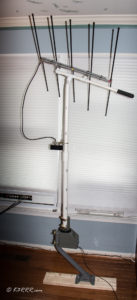
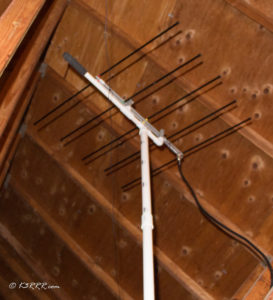


Willie, I will tell you that both the roof and the trees are a problems with signal attenuation – and the trees are worse than the roof! I will be doing a new video about the trees for my YouTube channel at YouTube.com/K3RRR – so you might want to subscribe to my channel so you can get automated notification the video is up.
-.- …– .-. .-. .-.
73 de Robert K3RRR
K3RRR.com ~~~~~~~~~~~ Visit My Web Site
@K3TripleR ~~~~~~~~~~ Follow Me On Twitter
YouTube.com/K3RRR ~~ Check Out My Videos
-.- …– .-. .-. .-.
i also track ham and weather sat and i use what is called a LNA low noise apmlifier with my sdrplay2 and what it does takes the low signal of the ham sat or weather sat and amplifies it be for it comes in it work great the other day when i test it with my friends EME lna but u got to keep in mind most LNA need a 5 volt power and you would need a adaptors like sma male to sma male and a sma male to pl259 or what ever it call but for the price it work good for tracking those sats that have weak returns signal etc if you got any question u can emal me a vapeandrew@gmail.com and i will be glad to help u any way that i can
73s
andrew
Question I have Pecan Trees in my back yard….I can do the Elk Sys and a nice rotor…about 15 to 18 feet above ground but the Pecan Trees, I am thinking if can shoot through the house roof, pecan trees should not be a problem, ? ? ? …please correct me LEOs pass east to west…my west side is good open sky.. east side is where the trees are…Ok.. Talk To me……. ( are you on DMR…) we can also talk there….